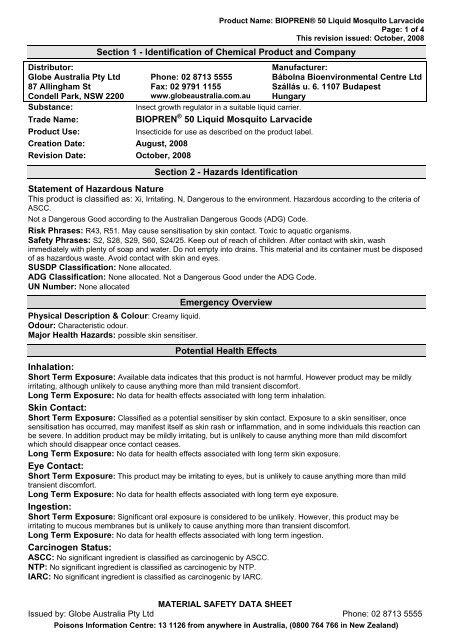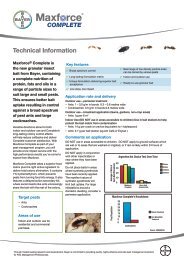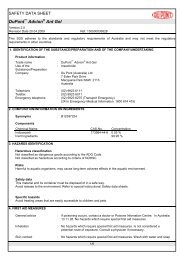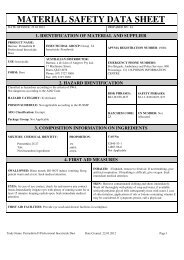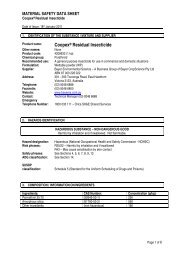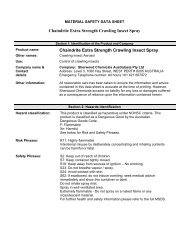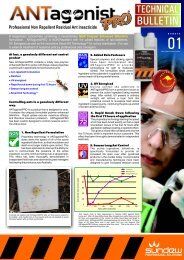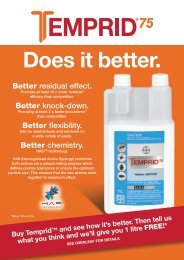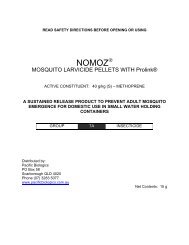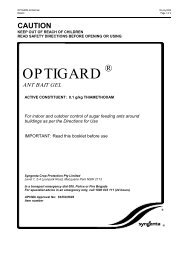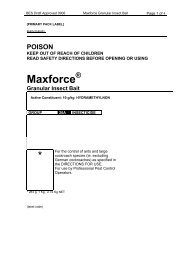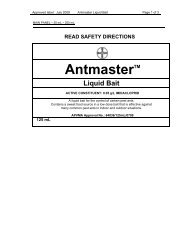BIOPREN® 50 Liquid Mosquito Larvacide - Globe Australia
BIOPREN® 50 Liquid Mosquito Larvacide - Globe Australia
BIOPREN® 50 Liquid Mosquito Larvacide - Globe Australia
You also want an ePaper? Increase the reach of your titles
YUMPU automatically turns print PDFs into web optimized ePapers that Google loves.
Product Name: <strong>BIOPREN®</strong> <strong>50</strong> <strong>Liquid</strong> <strong>Mosquito</strong> <strong>Larvacide</strong><br />
Page: 1 of 4<br />
This revision issued: October, 2008<br />
Section 1 - Identification of Chemical Product and Company<br />
Distributor:<br />
<strong>Globe</strong> <strong>Australia</strong> Pty Ltd Phone: 02 8713 5555<br />
Manufacturer:<br />
Bábolna Bioenvironmental Centre Ltd<br />
87 Allingham St Fax: 02 9791 1155 Szállás u. 6. 1107 Budapest<br />
Condell Park, NSW 2200 www.globeaustralia.com.au Hungary<br />
Substance:<br />
Insect growth regulator in a suitable liquid carrier.<br />
Trade Name:<br />
BIOPREN ® <strong>50</strong> <strong>Liquid</strong> <strong>Mosquito</strong> <strong>Larvacide</strong><br />
Product Use:<br />
Insecticide for use as described on the product label.<br />
Creation Date: August, 2008<br />
Revision Date: October, 2008<br />
Section 2 - Hazards Identification<br />
Statement of Hazardous Nature<br />
This product is classified as: Xi, Irritating. N, Dangerous to the environment. Hazardous according to the criteria of<br />
ASCC.<br />
Not a Dangerous Good according to the <strong>Australia</strong>n Dangerous Goods (ADG) Code.<br />
Risk Phrases: R43, R51. May cause sensitisation by skin contact. Toxic to aquatic organisms.<br />
Safety Phrases: S2, S28, S29, S60, S24/25. Keep out of reach of children. After contact with skin, wash<br />
immediately with plenty of soap and water. Do not empty into drains. This material and its container must be disposed<br />
of as hazardous waste. Avoid contact with skin and eyes.<br />
SUSDP Classification: None allocated.<br />
ADG Classification: None allocated. Not a Dangerous Good under the ADG Code.<br />
UN Number: None allocated<br />
Emergency Overview<br />
Physical Description & Colour: Creamy liquid.<br />
Odour: Characteristic odour.<br />
Major Health Hazards: possible skin sensitiser.<br />
Potential Health Effects<br />
Inhalation:<br />
Short Term Exposure: Available data indicates that this product is not harmful. However product may be mildly<br />
irritating, although unlikely to cause anything more than mild transient discomfort.<br />
Long Term Exposure: No data for health effects associated with long term inhalation.<br />
Skin Contact:<br />
Short Term Exposure: Classified as a potential sensitiser by skin contact. Exposure to a skin sensitiser, once<br />
sensitisation has occurred, may manifest itself as skin rash or inflammation, and in some individuals this reaction can<br />
be severe. In addition product may be mildly irritating, but is unlikely to cause anything more than mild discomfort<br />
which should disappear once contact ceases.<br />
Long Term Exposure: No data for health effects associated with long term skin exposure.<br />
Eye Contact:<br />
Short Term Exposure: This product may be irritating to eyes, but is unlikely to cause anything more than mild<br />
transient discomfort.<br />
Long Term Exposure: No data for health effects associated with long term eye exposure.<br />
Ingestion:<br />
Short Term Exposure: Significant oral exposure is considered to be unlikely. However, this product may be<br />
irritating to mucous membranes but is unlikely to cause anything more than transient discomfort.<br />
Long Term Exposure: No data for health effects associated with long term ingestion.<br />
Carcinogen Status:<br />
ASCC: No significant ingredient is classified as carcinogenic by ASCC.<br />
NTP: No significant ingredient is classified as carcinogenic by NTP.<br />
IARC: No significant ingredient is classified as carcinogenic by IARC.<br />
MATERIAL SAFETY DATA SHEET<br />
Issued by: <strong>Globe</strong> <strong>Australia</strong> Pty Ltd Phone: 02 8713 5555<br />
Poisons Information Centre: 13 1126 from anywhere in <strong>Australia</strong>, (0800 764 766 in New Zealand)
Product Name: <strong>BIOPREN®</strong> <strong>50</strong> <strong>Liquid</strong> <strong>Mosquito</strong> <strong>Larvacide</strong><br />
Page: 2 of 4<br />
This revision issued: October, 2008<br />
Section 3 - Composition/Information on Ingredients<br />
Ingredients CAS No Conc,% TWA (mg/m 3 ) STEL (mg/m 3 )<br />
S-methoprene 65733-16-6 5 not set not set<br />
Polyethylene-glycol-15-hydroxy-stearate 70142-34-6 12 not set not set<br />
Other non hazardous ingredients secret to 100 not set not set<br />
This is a commercial product whose exact ratio of components may vary slightly. Minor quantities of other non<br />
hazardous ingredients are also possible.<br />
The ASCC TWA exposure value is the average airborne concentration of a particular substance when calculated over a normal 8 hour working day<br />
for a 5 day working week. The STEL (Short Term Exposure Limit) is an exposure value that may be equalled (but should not be exceeded) for no<br />
longer than 15 minutes and should not be repeated more than 4 times per day. There should be at least 60 minutes between successive exposures<br />
at the STEL. The term "peak "is used when the TWA limit, because of the rapid action of the substance, should never be exceeded, even briefly.<br />
Section 4 - First Aid Measures<br />
General Information:<br />
You should call The Poisons Information Centre if you feel that you may have been poisoned, burned or irritated by<br />
this product. The number is 13 1126 from anywhere in <strong>Australia</strong> (0800 764 766 in New Zealand) and is available at all<br />
times. Have this MSDS with you when you call.<br />
Inhalation: First aid is not generally required. If in doubt, contact a Poisons Information Centre or a doctor.<br />
Skin Contact: Irritation is unlikely. However, if irritation does occur, flush with lukewarm, gently flowing water for 5<br />
minutes or until chemical is removed.<br />
Eye Contact: No effects expected. If irritation does occur, flush contaminated eye(s) with lukewarm, gently flowing<br />
water for 5 minutes or until the product is removed. Obtain medical advice if irritation becomes painful or lasts more<br />
than a few minutes. Take special care if exposed person is wearing contact lenses.<br />
Ingestion: If product is swallowed or gets in mouth, do NOT induce vomiting; wash mouth with water and give some<br />
water to drink. If symptoms develop, or if in doubt contact a Poisons Information Centre or a doctor.<br />
Section 5 - Fire Fighting Measures<br />
Fire and Explosion Hazards: There is no risk of an explosion from this product under normal circumstances if it is<br />
involved in a fire.<br />
Only small quantities of decomposition products are expected from this products at temperatures normally achieved in<br />
a fire. This will only occur after heating to dryness.<br />
Fire decomposition products from this product are likely to be irritating if inhaled.<br />
Extinguishing Media: Not Combustible. Use extinguishing media suited to burning materials.<br />
Fire Fighting: If a significant quantity of this product is involved in a fire, call the fire brigade.<br />
Flash point:<br />
Does not burn.<br />
Upper Flammability Limit: Does not burn.<br />
Lower Flammability Limit: Does not burn.<br />
Autoignition temperature: Not applicable - does not burn.<br />
Flammability Class: Does not burn.<br />
Section 6 - Accidental Release Measures<br />
Accidental release: In the event of a major spill, prevent spillage from entering drains or water courses. Wear full<br />
protective clothing including eye/face protection. All skin areas should be covered. See below under Personal<br />
Protection regarding <strong>Australia</strong>n Standards relating to personal protective equipment. Suitable materials for protective<br />
clothing include rubber, PVC, Viton. Eye/face protective equipment should comprise as a minimum, protective<br />
goggles. If there is a significant chance that vapours or mists are likely to build up in the cleanup area, we recommend<br />
that you use a respirator. Usually, no respirator is necessary when using this product. However, if you have any<br />
doubts consult the <strong>Australia</strong>n Standard mentioned below (section 8).<br />
Stop leak if safe to do so, and contain spill. Absorb onto sand, vermiculite or other suitable absorbent material. If spill<br />
is too large or if absorbent material is not available, try to create a dike to stop material spreading or going into drains<br />
or waterways. Sweep up and shovel or collect recoverable product into labelled containers for recycling or salvage,<br />
and dispose of promptly. Recycle containers wherever possible after careful cleaning. After spills, wash area<br />
preventing runoff from entering drains. If a significant quantity of material enters drains, advise emergency services.<br />
This material may be suitable for approved landfill. Ensure legality of disposal by consulting regulations prior to<br />
disposal. Thoroughly launder protective clothing before storage or re-use. Advise laundry of nature of contamination<br />
when sending contaminated clothing to laundry.<br />
MATERIAL SAFETY DATA SHEET<br />
Issued by: <strong>Globe</strong> <strong>Australia</strong> Pty Ltd Phone: 02 8713 5555<br />
Poisons Information Centre: 13 1126 from anywhere in <strong>Australia</strong>, (0800 764 766 in New Zealand)
Product Name: <strong>BIOPREN®</strong> <strong>50</strong> <strong>Liquid</strong> <strong>Mosquito</strong> <strong>Larvacide</strong><br />
Page: 3 of 4<br />
This revision issued: October, 2008<br />
Section 7 - Handling and Storage<br />
Handling: Keep exposure to this product to a minimum, and minimise the quantities kept in work areas. Check<br />
Section 8 of this MSDS for details of personal protective measures, and make sure that those measures are followed.<br />
The measures detailed below under "Storage" should be followed during handling in order to minimise risks to<br />
persons using the product in the workplace. Also, avoid contact or contamination of product with incompatible<br />
materials listed in Section 10.<br />
Storage: Store in the closed original container in a dry, cool, well-ventilated area out of direct sunlight. Make sure<br />
that the product does not come into contact with substances listed under "Incompatibilities" in Section 10. Some liquid<br />
preparations settle or separate on standing and may require stirring before use. Check packaging - there may be<br />
further storage instructions on the label.<br />
Section 8 - Exposure Controls and Personal Protection<br />
The following <strong>Australia</strong>n Standards will provide general advice regarding safety clothing and equipment:<br />
Respiratory equipment: AS/NZS 1715, Protective Gloves: AS 2161, Industrial Clothing: AS2919, Industrial Eye<br />
Protection: AS1336 and AS/NZS 1337, Occupational Protective Footwear: AS/NZS2210.<br />
ASCC Exposure Limits TWA (mg/m 3 ) STEL (mg/m 3 )<br />
Exposure limits have not been established by ASCC for any of the significant ingredients in this product.<br />
No special equipment is usually needed when occasionally handling small quantities. The following instructions are<br />
for bulk handling or where regular exposure in an occupational setting occurs without proper containment systems.<br />
Ventilation: This product should only be used in a well ventilated area. If natural ventilation is inadequate, use of a<br />
fan is suggested.<br />
Eye Protection: Eye protection such as protective glasses or goggles is recommended when this product is being<br />
used.<br />
Skin Protection: If you believe you may have a sensitisation to this product or any of its declared ingredients, you<br />
should prevent skin contact by wearing impervious gloves, clothes and, preferably, apron. Make sure that all skin<br />
areas are covered. See below for suitable material types.<br />
Protective Material Types: We suggest that protective clothing be made from the following materials: rubber,<br />
PVC, Viton.<br />
Respirator: Usually, no respirator is necessary when using this product. However, if you have any doubts consult<br />
the <strong>Australia</strong>n Standard mentioned above.<br />
Section 9 - Physical and Chemical Properties:<br />
Physical Description & colour: Creamy liquid.<br />
Odour:<br />
Characteristic odour.<br />
Boiling Point:<br />
Approximately 100°C at 100kPa.<br />
Freezing/Melting Point: Approximately 0°C.<br />
Volatiles:<br />
Water component.<br />
Vapour Pressure:<br />
2.37 kPa at 20°C (water vapour pressure).<br />
Vapour Density:<br />
No data.<br />
Specific Gravity: 1.02<br />
Water Solubility:<br />
Dispersible.<br />
pH: 6-7<br />
Volatility:<br />
No data.<br />
Odour Threshold:<br />
No data.<br />
Evaporation Rate:<br />
No data.<br />
Coeff Oil/water Distribution: No data<br />
Autoignition temp:<br />
Not applicable - does not burn.<br />
Section 10 - Stability and Reactivity<br />
Reactivity: This product is unlikely to react or decompose under normal storage conditions. However, if you have<br />
any doubts, contact the supplier for advice on shelf life properties.<br />
Conditions to Avoid: Store in the closed original container in a dry, cool, well-ventilated area out of direct sunlight.<br />
Incompatibilities: No particular Incompatibilities.<br />
Fire Decomposition: Only small quantities of decomposition products are expected from this products at<br />
temperatures normally achieved in a fire. This will only occur after heating to dryness. Carbon dioxide, and if<br />
combustion is incomplete, carbon monoxide. Water. Carbon monoxide poisoning produces headache, weakness,<br />
nausea, dizziness, confusion, dimness of vision, disturbance of judgment, and unconsciousness followed by coma<br />
and death.<br />
MATERIAL SAFETY DATA SHEET<br />
Issued by: <strong>Globe</strong> <strong>Australia</strong> Pty Ltd Phone: 02 8713 5555<br />
Poisons Information Centre: 13 1126 from anywhere in <strong>Australia</strong>, (0800 764 766 in New Zealand)
Product Name: <strong>BIOPREN®</strong> <strong>50</strong> <strong>Liquid</strong> <strong>Mosquito</strong> <strong>Larvacide</strong><br />
Page: 4 of 4<br />
This revision issued: October, 2008<br />
Polymerisation: This product will not undergo polymerisation reactions.<br />
Local Effects:<br />
Target Organs:<br />
Section 11 - Toxicological Information<br />
There is no data to hand indicating any particular target organs.<br />
Classification of Hazardous Ingredients<br />
Ingredient<br />
Risk Phrases<br />
No ingredient mentioned in the HSIS Database is present in this product at hazardous concentrations.<br />
LD <strong>50</strong> Oral, Rat ><strong>50</strong>00mg/kg<br />
LD <strong>50</strong> Dermal, Rat = >2000mg/kg<br />
Section 12 - Ecological Information<br />
This product is toxic to aquatic organisms. This product is biodegradable. It will not accumulate in the soil or water or<br />
cause long term problems.<br />
S-methoprene: Fish: LC <strong>50</strong> rainbow trout (Oncorhynchus mykiss): 0.76mg/L<br />
Section 13 - Disposal Considerations<br />
Disposal: This product may be recycled if unused, or if it has not been contaminated so as to make it unsuitable for<br />
its intended use. If it has been contaminated, it may be possible to separate the contamination in some way. Only if<br />
neither of these options is suitable, consider landfill.<br />
Section 14 - Transport Information<br />
ADG Code: This product is not classified as a Dangerous Good. No special transport conditions are necessary<br />
unless required by other regulations.<br />
Section 15 - Regulatory Information<br />
AICS: All of the significant ingredients in this formulation are compliant with NICNAS regulations.<br />
Acronyms:<br />
ADG Code<br />
AICS<br />
ASCC<br />
CAS number<br />
Hazchem Code<br />
IARC<br />
NOS<br />
NTP<br />
R-Phrase<br />
SUSDP<br />
UN Number<br />
Section 16 - Other Information<br />
This MSDS contains only safety-related information. For other data see product literature.<br />
<strong>Australia</strong>n Code for the Transport of Dangerous Goods by Road and Rail (7 th edition)<br />
<strong>Australia</strong>n Inventory of Chemical Substances<br />
Office of the <strong>Australia</strong>n Safety and Compensation Council<br />
Chemical Abstracts Service Registry Number<br />
Emergency action code of numbers and letters that provide information to emergency<br />
services especially firefighters<br />
International Agency for Research on Cancer<br />
Not otherwise specified<br />
National Toxicology Program (USA)<br />
Risk Phrase<br />
Standard for the Uniform Scheduling of Drugs & Poisons<br />
United Nations Number<br />
THIS MSDS SUMMARISES OUR BEST KNOWLEDGE OF THE HEALTH AND SAFETY HAZARD INFORMATION OF THE PRODUCT AND<br />
HOW TO SAFELY HANDLE AND USE THE PRODUCT IN THE WORKPLACE. EACH USER MUST REVIEW THIS MSDS IN THE CONTEXT OF<br />
HOW THE PRODUCT WILL BE HANDLED AND USED IN THE WORKPLACE.<br />
IF CLARIFICATION OR FURTHER INFORMATION IS NEEDED TO ENSURE THAT AN APPROPRIATE RISK ASSESSMENT CAN BE MADE,<br />
THE USER SHOULD CONTACT THIS COMPANY SO WE CAN ATTEMPT TO OBTAIN ADDITIONAL INFORMATION FROM OUR SUPPLIERS<br />
OUR RESPONSIBILITY FOR PRODUCTS SOLD IS SUBJECT TO OUR STANDARD TERMS AND CONDITIONS, A COPY OF WHICH IS SENT<br />
TO OUR CUSTOMERS AND IS ALSO AVAILABLE ON REQUEST.<br />
Please read all labels carefully before using product.<br />
This MSDS is prepared in accord with the ASCC document “National Code of Practice for the Preparation<br />
of Material Safety Data Sheets” 2nd Edition [NOHSC:2011(2003)]<br />
Copyright © Kilford & Kilford Pty Ltd, October, 2008.<br />
http://www.kilford.com.au/ Phone (02)9251 4532<br />
®<br />
Registered Trademark of Bábolna Bioenvironmental Centre Ltd<br />
MATERIAL SAFETY DATA SHEET<br />
Issued by: <strong>Globe</strong> <strong>Australia</strong> Pty Ltd Phone: 02 8713 5555<br />
Poisons Information Centre: 13 1126 from anywhere in <strong>Australia</strong>, (0800 764 766 in New Zealand)


